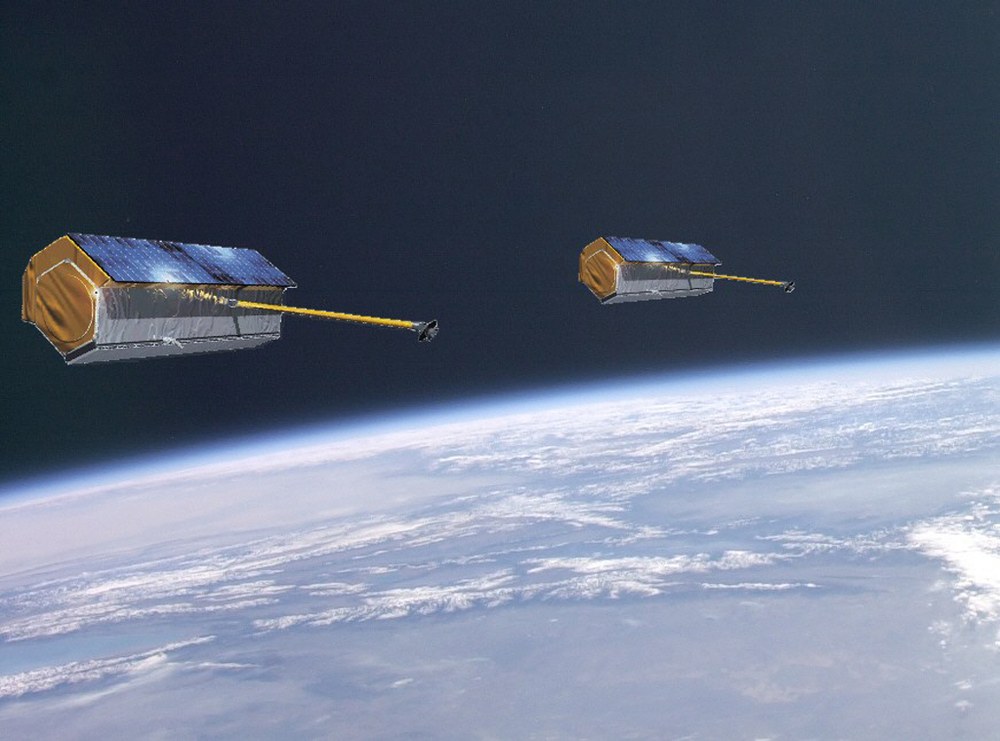TanDEM-X Autonomous Formation Flying Experiment (TAFF)

TanDEM-X Mission Overview
Germany is presently preparing the first operational formation flying mission for Synthetic Aperture Radar SAR) interferometry in low Earth orbit. It comprises two nearly identical spacecraft, named TSX and TDX, which have a size of 5 m x 2.4 m, a mass of 1200 kg and carry a high-resolution synthetic aperture (SAR) radar operating in the X-band (9.65 GHz). TSX has been launched by a DNEPR rocket on June 15, 2007 and was injected into a 514 km sun-synchronous dusk-dawn orbit with 97° inclination. This orbit has an 11 day repeat cycle and will be maintained troughout the mission with an accuracy of 250 m perpendicular to the flight direction. TDX will join the same orbit in 2009, after which the two spacecraft will fly in a precisely controlled formation to form a radar interferometer with typical baselines of 0.5 km. This allows a much higher resolution than achievable in the X-SAR/SRTM Shuttle Topography mission and thus the generation of digital elevation models (DEMs) with unrivaled accuracy. A global mapping of the Earth will be achieved within 3 years during the guaranteed joint lifetime of TSX and TDX. Secondary objectives of the TanDEM-X mission include the demonstration of along-track-SAR interferometry for ocean current measurements as well as polarimetric SAR-interferometry.
Formation Control Concept
A safe and robust maintenance of the formation is based on the concept of relative eccentricity/inclination (e/i) vector separation whose efficiency has already been demonstrated during the Gravity Recovery and Climate Experiment (GRACE). Here, the satellite relative motion is parameterized by mean of relative orbit elements and the key idea is to align the relative eccentricity and inclination vectors to minimize the hazard of a collision. The
task of TDX is to maintain the close formation configuration by actively controlling its relative motion with respect to TSX, the leader of the formation. TDX must replicate the absolute orbit keeping maneuvers executed by TSX and also compensate the natural deviation of the relative e/i vectors. In fact the relative orbital elements of the formation tend to drift because of the secular non-keplerian perturbations acting on both satellites. The goal of the ground segment is thus to regularly correct this configuration by performing small orbit correction maneuvers on TDX. The ground station contacts are limited due to the geographic position of the station and the costs for contact time. Only with a polar ground station a contact visibility is possible every orbit for LEO satellites. TSX and TDX use only the Weilheim ground station (in the southern part of Germany) during routine operations. This station allows two scheduled contact per day for the nominal orbit configuration, meaning that the satellite conditions can be checked with an interval of 12 hours. While this limitation is usually not critical for single satellite operations, the visibility constraints drive the achievable orbit control accuracy for a LEO formation if a ground based approach is chosen. Along-track position uncertainties and maneuver execution errors affect the relative motion and can be compensated only after a ground station contact.
Autonomous Formation Flying

In order to ease on-ground operations and make maximum reuse of the available on-board resources, the TDX spacecraft will be complemented with an Autonomous Formation Flying (TAFF) system. The objective of TAFF is to provide onboard TDX a robust control algorithm for formation keeping and to demonstrate a substitution of ground-based formation control by a space-borne autonomy function. The relative orbit solution is determined from the n avigation solutions provided by two synchronized GPS receivers onboard TSX and TDX. Information about TSX is transmitted to TDX through the Inter-Satellite Link (ISL). The on-board navigation module uses an extended Kalman filter and can cope with ISL data gaps of maximum 15 minutes. The expected navigation accuracy is at the meter level. Overall, tasks like orbit determination and control that are traditionally performed on-ground will be transferred to the spacecraft to enable improved relative orbit control performances. Since the orbit control maneuvers are planned and executed more frequently, typically every 3-5 hours, the autonomously controlled formation remains closer to the nominal configuration. The resulting control error is expected to be ten times better (i.e. 20 m, 3D 1 sigma) than via ground-based control. The adoption of an autonomous orbit control system on TanDEM-X will enhance the quality of the scientific data products and, on the long-term, reduce the required ground support and the associated costs.
Further Reading
Ardaens J.-S., D'Amico S., Ulrich D., Fischer D.;
TanDEM-X Autonomous Formation Flying System;
3rd International Symposium on Formation Flying, Missions and Technology, 23-25 April 2008, ESA/ESTEC, Noordwijk (2008).
D'Amico S., Montenbruck O.;
Proximity Operations of Formation Flying Spacecraft using an Eccentricity/Inclination Vector Separation;
AIAA Journal of Guidance, Control and Dynamics, 29/3 554-563 (2006).
Ardaens J.S., D'Amico S., Kazeminejad B., Montenbruck O., Gill E.;
Spaceborne Autonomous and Ground Based Relative Orbit Control for the TerraSAR-X/TanDEM-X Formation;
20th International Symposium on Space Flight Dynamics; 24-28 Sep. 2007, Annapolis, USA (2007).
